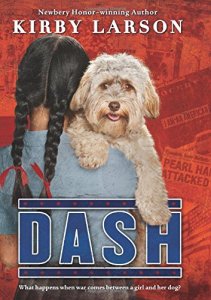Dash by Kirby Larson. Scholastic, 2014. 256 pages.
Reading Level: Middle Grades, ages 8-12
Recommended for: Ages 8-12
Eleven-year-old Mitsi’s best friend is her little dog, Dash. She used to have some other best friends, but after the attacks on Pearl Harbor, they’ve been avoiding Mitsi because she is Japanese American. And so the story opens on a lonely little girl who is trying to understand why the world is suddenly so very different from the friendly place she’s grown to expect. Mitsi’s family ends up being among the many Japanese Americans in 1942 who are sent to internment camps. Mitsi and her family must leave everything behind—including Dash—and move into a one-room cabin in a long line of one-room cabins in a big, muddy, fenced-in “camp.” Camp life is harsh, and Mitsi’s sorrow at losing her canine buddy nearly consumes her. Although she doesn’t understand much of what is happening on the broader global scale, Mitsi is troubled at her brother’s nefarious friends, the evident sorrow she sees in those who’ve lost their husbands/fathers, and the humiliation her own family must face at being forced to leave their home. By the end of the story, Mitsi has made new friends, her family is a stronger unit, and she is reunited—at long last—with her beloved Dash.
Larson is a talented author, but her treatment of the Japanese-American experience is not as strong as it might be. Camp conditions are portrayed clearly, but the end of the book leaves Mitsi’s family settling in, happy for small victories (such as their new ability to keep their pets). The camps are not condoned, but perhaps the picture would be more effective if there weren’t quite so many loose ends tied up so neatly. Still, this is a worthy addition to the genre of middle-grade WWII novels, not least because it does treat the Japanese-American experience in the camps on our soil. A suitable read for younger readers who are just beginning to learn about this troubling period in history, Dash will work well alongside other Holocaust stories for the eight- to ten-year-old crowd and should prompt some thought-provoking questions in its young readers. Larson also wrote Duke, featuring a boy and his dog during wartime in Germany.
Cautions: none
Overall Value: 3.5 (out of 5)
- Artistic Value: 3.5
- Worldview Value: 3.5
Categories: Historical Fiction, Middle Grades, History, Character Values, Multicultural, Award Winners
Thanks to the publisher via NetGalley for an advance copy of this work in return for an unbiased review
Cover image from amazon
Support our writers and help keep Redeemed Reader ad-free by joining the Redeemed Reader Fellowship.
Stay Up to Date!
Get the information you need to make wise choices about books for your children and teens.
Our weekly newsletter includes our latest reviews, related links from around the web, a featured book list, book trivia, and more. We never sell your information. You may unsubscribe at any time.
We'd love to hear from you!
Our comments are now limited to our members (both Silver and Golden Key). Members, you just need to log in with your normal log-in credentials!
Not a member yet? You can join the Silver Key ($2.99/month) for a free 2-week trial. Cancel at any time. Find out more about membership here.
2 Comments
Leave a Comment
You must be logged in to post a comment.



What an important topic for kids to learn about! The Canadian government did the same thing, and there is a Dear Canada book about it. (I haven’t read it yet, but intend to read it, maybe out loud to my daughter.) It’s interesting that you felt like it was maybe too “wrapped up”. Do you think that’s a result of not wanting to be too real with that age group? What do you think is the balance in terms of writing for the middle grade crowd?
That’s a good question, Steph. I don’t know what the best approach is, to be honest. I know that in NUMBER THE STARS, the reader knows that Ellen and her family will be safe, but there’s also an undercurrent of awareness that things are still unsettled and will be until the end of the war. So, perhaps Dash would be stronger with some sort of indication that the camps are temporary and that life WILL be different/harsher/more troubling until they really do get back home. One of the key differences in middle grade fiction versus YA fiction is that the protagonists DO come back home or, at the very least, end the book in solidarity with their family. To that end, Dash does show Mitsi and her family more settled at the end. Still, I wish there was a hint that things would be even MORE settled when they were able to return home. I think it’s a good book to bring up the topic with middle grade students, but I think Janie Cheaney’s MY FRIEND, THE ENEMY is a little more effective in the treatment of the prejudice against the Japanese-Americans during that time period even though it doesn’t take place in the internment camps. If you stumble across other titles along these lines that handle these topics well, pass them along!